Illegal And Controversial Food From Around The World
There's no question about it, we all enjoy a good taboo. We live for the thrill of breaking rules and experience a sudden rush of excitement whenever we come close to such illicit activities, because we know that we shouldn't be doing it. Let's face it, bad is good.
Skip to it...
More Articles...
- The Most Expensive And Luxurious Hotel Suites In The World
- Weird (And Slightly Disgusting) Food From Around the World
- Illegal And Controversial Food From Around The World
- 7 of the Worst Travel Nightmares Ever
- Common Travel Scams Exposed and Explained: Don't Fall Victim
- The Worst Travel Destinations in the World
- The Most Extreme and Isolated Places to Live in the World
- Fancy Trying Something New For Dinner?
- Things You Don’t Want Inside You While On Holiday
- 10 Highest Bodycount Plane Crashes
- 10 Deadly Places and Why You Have to See Them
- Stunning Videogame Locales - Exotic and Fantastic Locations That We Wish We Could Visit (And Some We’d Take Guns To)
- Stunning Videogame Locales Redux - More Awesome Places To Visit (But We’d Still Bring Guns To Some Of Them)
- 18 Awesome Aircraft Landings
- Fictional Metals That Are Made Of Pure Awesome
- Freakish Animals That Want To Kill You
- 10 of the Most Expensive Private Islands in the World
We eat junk food because we know it's bad for us and we get pleasure from this, it's enjoyable. But on the scale of crimes as perceived by The Law, consuming junk food is hardly a great offense; it hardly even offends the senses. Now, if you were to consume something that was actually illegal or at least extremely controversial, imagine the proverbial rush from that.
This is a list of meals and delicacies that push the envelope, with some of the latter dishes going on to open up said envelope, read what's inside, set fire to it and then snort the ashes. These are the culinary equivalent of murder, of robbing a bank, of snatching an old lady's purse. They are at best controversial and at worst, downright illegal. But all are delicious. Probably.
Horse Meat
A tasty meat-based treat, horse meat isn't a euphemism for anything; it's just the meat from a horse. You know, those things that pull carts and carry spoilt girls around on their backs? It turns out that various places (and perhaps more than you'd think) around the world have a keen interest in horse meat, producing vast quantities of the stuff for human consumption.
In a report produced in 2005, it was found that the eight leading horsemeat-producing countries produced over 700,000 tons and China leading the way by a long margin, producing over 200,000 of those 700,000 tons.
Horse meat may not be a major meat outside of Central Asia, but that still doesn't stop the fact that people eat horses from all over the world, including some parts of Europe and South America. It is typically seen as a taboo meat primarily because of the role horses have played in many cultures, namely that of worker, pet and companion, as it apparently seems strange to eat one's companions.
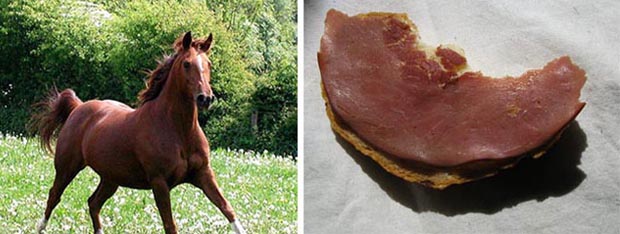
Turtles
Everyone loves turtles, those cute, green, sometimes ninja, sometimes hero things that playfully waddle around, bumping into things and occasionally being placed on their backs to watch them struggle. Well, it turns out that people like eating them as well, for they are delicious.
There a number of ways in which to prepare a turtle for consumption, the most civilized of which might just be turtle soup. This involves using "parts" of the turtle (i.e. meat, skin and other bits from inside the turtle) being cooked into a soup-based stew that is - especially in China and parts of Asia - considered a delicacy.
If a soup isn't your thing, then you can make use of my personal favorite method of turtle preparation: killing them, then ripping out all of their guts, replacing them with hot stones which then proceed to cook the dead creature from the inside out, thus preparing some delightful cooked turtle meat for all to partake of.
Turtle eating isn't just limited to Asia or similar, as turtle soup is a popular dish in the US as well, although rather than using endangered species of turtle, it's more common to use the - *ahem* - Common Snapping Turtle (Chelydra serpentine) as the main ingredient.

Snake Blood Wine
Just as it sounds, snake blood wine is wine, but with added snake blood. Another, less common variety is snake blood straight up, with no additions or extras, just cut the head from a snake and point its spurting lifeblood in the direction of a shot glass.
Snake wine is another of those peculiar beverages that can be found prominently in Southeast Asia and Traditional Chinese medicine even believes that the wine has restorative and invigorative properties.
There are a couple of varieties of snake blood wine, which include steeped and mixed versions. The steeped version involves dropping a large snake into a jar of rice wine; usually along with a bunch of smaller snakes and assorted herbs which is then left to steep for several months as the wine absorbs the "goodness" from the snakes. Om nom nom.
The mixed variety involved the "mixing" of various body fluids from the snake (such as blood and/or bile, glorious bile) by slicing the snake along its stomach (or the aforementioned cutting of the head) and then draining it into a jug or jar containing rice wine. It's the drink that wiggles! At least, for a bit.
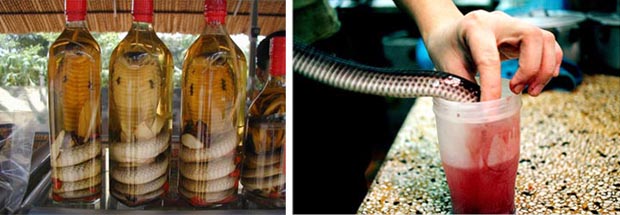
Foie Gras
Foie gras (meaning "fat liver" in French), or goose/duck liver is famous for the controversy it has caused due to the practice of gavage, or force-feeding, which involves sticking a long tube down the throat of a goose or duck and unleashing an unstoppable torrent of feed into the animal, making it Xbox huge.
The purpose of this is to enlarge the liver, making it fatty and especially delicious. The end result of this cruel method is foie gras; a culinary delight served the world over.
The controversy behind foie gras production has led to many an attempt to outright ban the product. Some US states have already outlawed foie gras, with many others expected to follow suit. European law has it so that foie gras can no longer be produced in countries in which it is not a long-established tradition (i.e. anywhere outside France, which accounts for 78.5% of the world's foie gras production). However, it can still be sold and consumed in many countries, so has done little to stem the tide of foie gras flowing into restaurants everywhere.
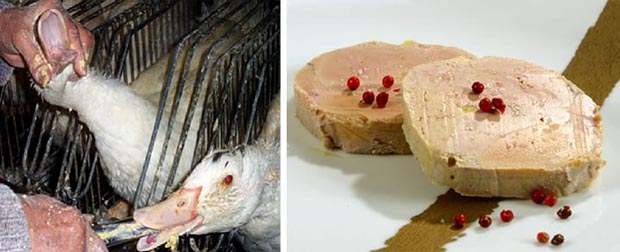
Fugu
Another relatively famous dish, this time from Japan, fugu is the Japanese word for puffer fish and also a dish consisting of the fish, which in turn is highly poisonous and can kill a person almost instantly.
Chefs are specially trained to prepare the fugu with the utmost dedication and care so as to perform their task correctly, lest they make a grievous error in preparation which could lead to a potential death. In other words, if the chef screws up, you will die.
Because of this element of danger that is associated with the fugu dish, as well as the skill of the chef needed to prepare it, fugu can be an extremely expensive meal in itself (and might even cost you your life), with top fugu meals fetching hundreds of dollars at some of the better restaurants.
The fish itself is purported to be incredibly tasty, with the flavor enhanced by the chance of death that it brings and allegedly, the more poisonous the type of fish used, the tastier it is. Death has never tasted so good. Except in everything on this list.
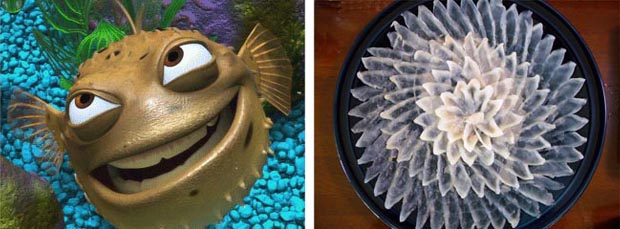
Drunken Shrimp
Unethical purely for the fact that this meal involves eating live animals. Yes, everything (being the shrimp) on your plate will still be alive and squirming as it enters your mouth.
Drunken shrimp is in no way referring to the Western practice of marinating shrimp in alcohol prior to cooking, but rather the method by which still-living shrimp are stunned in strong liquor before being eaten, thus they are "drunken shrimp".
The shrimp are simply placed into a bowl that contains the liquor - normally baijiu - to render them "drunken" (or just plain drowned) and therefore easier to eat, as they are less snappy and prone to moving around.
Here's a video of a man eating drunken shrimp and breaking his glasses, for the sake of posterity.
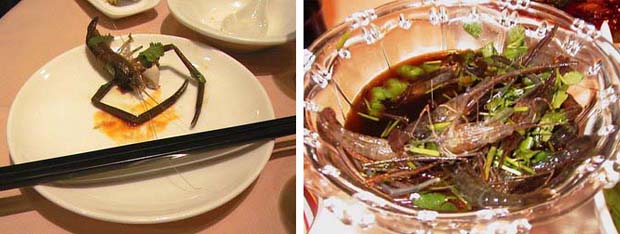
Live Frog Heart
This is a video of a man eating the still-beating heart of a frog.
The clip was taken from the first episode of Andrew Zimmern's Bizarre Foods TV show, in which he's eating frog sashimi, with sashimi being a Japanese delicacy consisting of fresh, raw seafood. Very fresh, in fact.

Ikizukuri
Speaking of food that's served alive, the Japanese have a name for this practice: Ikizukuri.
This is the process via which sashimi is prepared from a living animal. The chef will take the fish to be served out from its fish tank and then filet and gut it in such a manner so as to prepare sashimi from it, but without killing the fish itself. The fish - still alive (albeit briefly, I'd imagine) - is then usually served on a plate as decoration to the sashimi made from its own flesh. The shock must be somewhat extreme for the poor fish.
Ikizukuri isn't just limited to the flesh of fish; shrimp, octopus and squid can also be on the ikizukuri-related menu. Generally, octopus and squid are wrapped whole and alive around a pair of chopsticks and then eaten in one go.
Naturally, ikizukuri is a rather controversial method of food preparation, both inside Japan and in other countries. However, some Japanese - like some French when it comes to foie gras - will argue that it's part of the cultural heritage of the country and thus should be accepted as such.
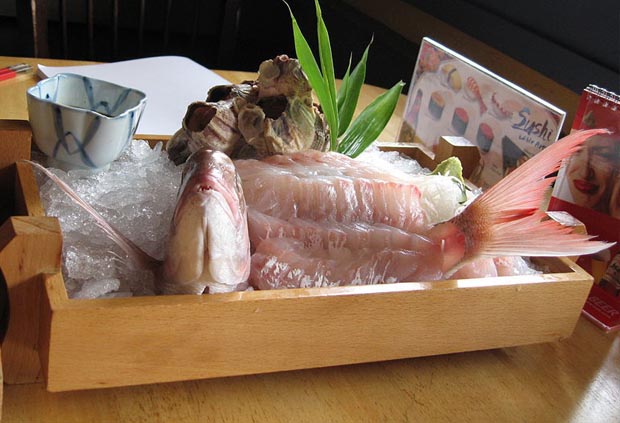
Ortolan
Also known as an Ortolan Bunting, this is essentially a tiny bird native to Europe and some of western Asia, but is also considered a rare delicacy in France, where the French have consumed it with such gusto that the ortolan is now in decline in most parts. Hunting of the ortolan exceeds 50,000 of the birds a year, which just so happens to be ten times the ortolan population of the Netherlands, Germany and Belgium). For these reasons, eating an ortolan is illegal. They must be delicious.
Made famous by the fact that former French president François Mitterrand consumed one in his decadent last meal and that Jeremy Clarkson ate one on TV, it is said that eating an ortolan is a rather unique experience.
The bird is captured alive, blinded and/or kept in a darkened cage to disrupt their feeding habits, then force-fed oats and millet to make it swell up to ridiculous proportions. After this measure of cruelty, the bird is then drowned in brandy and subsequently roasted. Then comes the eating.
The consumption of an ortolan is nearly ritualistic in nature, as the diner is required to place a napkin over their faces (so as to keep in the luxurious aroma of the cooked bird, but probably also to hide their crime from God). They would then place the entire bird inside their mouth, with only the beak or part of the head (unless the head has been removed prior to serving) protruding, which is then removed with a bite.
With headless bird in mouth, the diner now chews the tiny corpse for minutes on end, all the while savoring the multitude of flavors that wash over the tongue. Delightful.

Casu Marzu
A true nightmare amongst foodstuffs and a veritable blasphemy against cheese-kind the world over, Casu Marzu is one of those utterly disgusting abominations that is considered a "delicacy" by the local populace, local this time meaning Sardinia, Italy.
You know that when the locals start colloquially calling something "maggot cheese", something isn't quite right. Even the name of the cheese - Casu Marzu - literally translates as "rotten cheese" in Sardinian. This cheese is Bad Times made real, as if some entity comprised of Despair, Anguish and Malice has learned to transcend the Dark Beyond and manifest itself in our plane of reality, but in the form of a cheese.
The arcane ritual needed to summon this heinous devil-cheese requires the crazy cheese-alchemists of Sardinia to sacrifice an innocent Pecorino cheese by forcing it to go past a sanitary level of standard cheese fermentation into what you and I would most likely call decomposition (that's right, ROTTING, as in DEAD) and this is aided by the introduction of insects, more specifically, the cheese fly (Piophila casei).
With a resolve of steel (for nothing will sway them from their evil craft) and a wry grin of what must be insanity, these Sardinian cheese-makers willingly introduce the larvae of this cheese fly into their deliberately festering Pecorino cheese. Either that or a female will lay eggs (anything around 500 of the things at a time) into the cheese and upon hatching, a nightmarish swarm of larvae will begin to digest the cheese.
During this phase of the Casu Marzu-making process, the cheese weeps for the life it could have led as a potential Pecorino, as the cheese is prone to leaking. More specifically, a liquid can leak from the cheese, which is known by its cruel Sardinian taskmasters as lagrima, or "tears".
The acid from the digestive system of the larvae (read: maggots) breaks down the fats in the cheese, making it incredibly soft and no doubt resembling the insides of a ripe cadaver. Eventually, the wizened madmen constructing this disgrace against God will be able to tell when the cheese has achieved...Completion, where it's most likely fulminating with crawling maggots.
The cheese is considered "past its best" when the maggots have died, as this indicated that the cheese has become too toxic even for their - very acquired - tastes. Thusly, their hideous creation is only consumed when filled with maggots still a-writhin'.
But the show is not over yet folks, for there is still one obstacle left to traverse before you can commune with the Satan of Cheeses and that, dear friends, is the eating of the cheese. These maggots can launch themselves up to 6 inches if disturbed, generally requiring the would-be diner (no doubt an acolyte in this secret order) to shield their visage from the ghastly sight of the cheese with their hand (and to also protect their eyes).
The hilarious thing is that this cheese is illegal due to health and safety concerns. It's also illegal in the one place they can gather enough madmen to consume such a thing (Sardinia) and if the thought of a rotting lump of ex-cheese filled with thousands of tiny necrophages wasn't enough to sway them from eating it, then the potential for maggots to survive stomach acid and then subsequently bore through internal organs, causing enteric myaisis, amongst other things.
But hey, I'm sure some people love eating this.
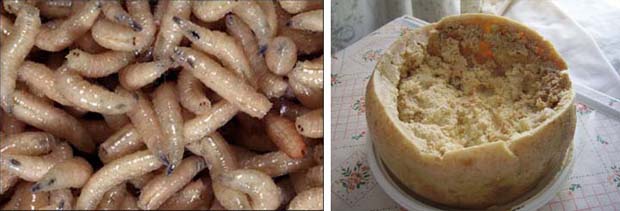
Bonus: Mellified Man
Included as a bonus primarily because the practice of making a mellified man is ridiculous in and of itself.
The idea of the mellified man was popularized by Mary Roach in her 2003 book Stiff: The Curious Lives of Human Cadavers, in which she posited the legend of the mellified man.
What would happen is that an elderly person in their late 70s or 80s, whose death was likely in the not-too-distant future, would donate their bodies to science in order to provide a special healing confection known as "mellified man".
The donor would consume only honey to the exclusion of all other food and drink, even bathing themselves in it. Over time, the donor would excrete honey from every orifice, even sweating it, as they were slowly mellified. Upon their inevitable death, they would be encased in a coffin filled to the brim with honey. The coffin was then dated and sealed for 100 years, after which it was opened and the occupant of the coffin had turned into some sort of disgusting confection which was rumored to have incredible healing properties.
This gloop was applied topically to areas in need of treatment and even consumed in some cases. Candied corpse, anyone?
The likelihood of this being true is up for debate, as records of this practice date back many hundreds of years, but it sure makes for an interesting story, don't you think?
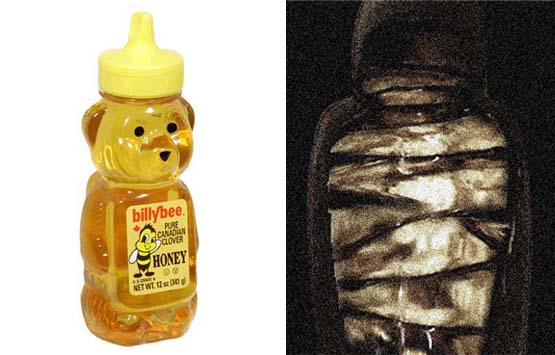
Find us on Google+
